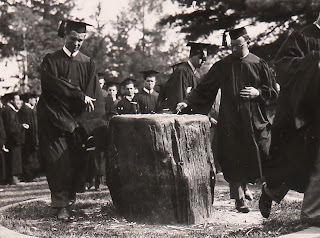 Class Day, usually the day preceding Commencement, began with the seniors meeting at the senior fence dressed in caps and gowns. From there they formed a procession, headed by the College band, and marched from the fence to the steps of Dartmouth Hall, where the class president gave a welcome speech. This was generally a short nostalgic piece that looked back at the class’s experience over the previous four years.
Class Day, usually the day preceding Commencement, began with the seniors meeting at the senior fence dressed in caps and gowns. From there they formed a procession, headed by the College band, and marched from the fence to the steps of Dartmouth Hall, where the class president gave a welcome speech. This was generally a short nostalgic piece that looked back at the class’s experience over the previous four years.The President’s address was followed by the Address to College and the Class Oration. In 1912 this was a short speech looking forward to life after College titled “The Other Eight Hours,” a discourse on work and avocation.
Following the oration, the procession reformed and marched to the Bema. Here the Class Poem was read. Again, nostalgia was the rule, but also an epic poem style was often adopted.
The darkness rests on mullion and rafter,The Class Poem was followed by the Sachem Oration. In later years this was done on the site of the Old Pine. This was more light-hearted and satirical. It was also done in full Indian garb and couched in Olde English.
High and unlit of the lamp below.
The great hall wakes with the lights and the laughter,
Of the last, long feast in the home we know.
The tapestries stir in their ancient places,
In the high-hung helms flicker spectral faces;
Sweet are the joys that toil comes after,
And the final goblet is emptied slow.
Give ear and hearken, ye braves of Occom. For many days the signals of the great hunt have burned and signs of the chase has been upon the hilltops. It is well then, that ye should meet in council, that ye should smoke the sacred peace pipe, and should see the smoke uprising, the Pukwana of the peace pipe, while you pledge anew as man to brother.
Since the whole idea of the Sachem Oration was based on the Hovey song “Eleazar,” it was often followed with a drink of rum, since that satirical song has Wheelock bringing a 500-gallon keg of rum with him to share with the imaginary Indians he met on the Hanover plain.
The Sachem Oration was followed by the class ode. This was a song or chant. In 1921 it was sung to the tune of an old Welsh song called the Men of Harlech. The ode began:
Here we stand with life before usAt this point the procession reformed and everyone adjourned to the Old Pine where the pipe smoking took place. This was a symbolic peace pipe ceremony related to the fictitious meeting between Eleazar Wheelock and the Abenaki Sachem, again, as depicted in Hovey’s song “Eleazar.” Traditional 18th-century style clay pipes were used.
Dartmouth’s green still waving o’er us
Raise a song in sounding chorus:
Dartmouth live for aye!
Once the pipes were smoked, they were broken on the stump of the Old Pine following its demise in 1892. This was to symbolize the breaking of the seniors’ bonds with the College in their role as students.
Here is a brief example from 1921:
Let us take a backward glimpse, for a moment, with the spirit of the Old Pine. Towering above its companions on this eminence, for nearly a century it greeted first the rising sun and was the last to catch its declining rays…. That majestic pine is gone. And yet the qualities called to mind by its remnant indicate the significance of this rite. Uprightness, vigor, and courage, the Old Pine had in its day; and we, too, must evidence these characteristics if we would as successfully rise to the places of superior trust and opportunity which the college has made possible for us.Finally the Dartmouth song was sung, the procession reformed and marched to the senior fence where they received their class books (the Aegis) and dispersed.


No comments :
Post a Comment